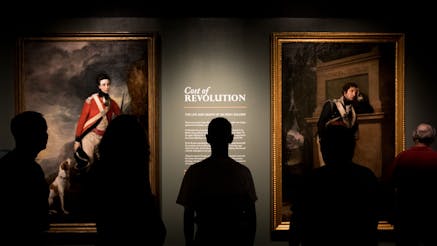Search Results
When Women Lost the Vote: A Revolutionary Story: Anne Cowperthwaite
When Women Lost the Vote: A Revolutionary Story: Caesar Trent
Picturing Washington's Army: West Point
In August 1782, Pierre Charles L’Enfant painted West Point, the administrative and strategic center of the Continental Army. Since the spring of 1778, West Point had become the army’s largest post. During that summer, New England troops dug entrenchments on the surrounding hills and built fortifications on Constitution Island, across the river. These buildings and fortifications are visible in L’Enfant’s scene.
Image courtesy of Library of Congress, Prints and Photographs Division, Washington, D.C.
The Davenport Letters: May 14, 1782
Shortly after writing his letter from West Point in January 1781, James Davenport was transferred to the light infantry company of the 8th Massachusetts. Light infantry soldiers were usually nimble young soldiers and more likely to be deployed in running fights and skirmishes. Davenport served in the Yorktown campaign and remembered being present at the surrender of the British Army in October 1781. Years later, James Davenport recalled his experiences at Yorktown to a local historian, who wrote:
“The regiment that this man belonged to had, previous to that event, suffered unnumbered privations, were continually on the alert, and their clothing was literally rags: he said nearly one-half of the regiment were barefoot; but their hearts were as true as the needle to the pole. The supplies which had been long expected from the government had not arrived; but, by perseverance and valor, the day of their deliverance was at hand… Our allies, the French, were drawn up in a long line on one side, and the Americans on the other; and the British troops, the prisoners, were to march out between the lines, with trailed arms, unloaded, and deposit them on the spot assigned. Our brave Yankees literally toed the line, for their feet were many of them bare; while the proud British soldiers were dressed, as the saying is, ’neat as a new pin,’ – every man had his hair powdered, and everyone was a prince to look to. My informant said that language was too feeble to describe the indignation and resentment of the British soldiers, plainly depicted in their countenances, to think that they had surrendered to such a dirty, ragged, weatherbeaten set of human beings; they gnashed their teeth, and shook their heads, and muttered out oaths and execrations too horrid to rehearse. All the while our victorious countrymen stood firm and unmoved, – guns loaded, swords drawn, hearts of steel: a glow of manly enthusiasm and joy beamed from every countenance; while the rude winds of heaven sported with their tattered garments.”
After 10 months of active campaigning, Davenport found himself back at West Point in 1782, where he wrote this letter in May. Davenport’s humor shines through in this letter, even if the joke he uses to explain ongoing anxiety about the war’s duration strikes us as a bit of a dad joke. Nonetheless, this was a difficult time for the Continental Army, with soldiers still largely unpaid and disgruntled.
Shortly before Davenport wrote this letter, soldiers in the Connecticut Line began to plot a mutiny. When they were discovered, one of them, Lud Gaylord of the 1st Connecticut, was executed on May 13, 1782. Davenport witnessed this execution but was largely unmoved. “It is very dull times here,” he wrote in his next sentence.

New Online Exhibit “Cost of Revolution: The Life and Death of an Irish Soldier” Now Available
When Women Lost the Vote: A Revolutionary Story: Amy Walker Cheston
Washington's Field Headquarters: George Washington’s Sleeping Marquee
Click on the numbers here to learn more about the components of the tent and to see images of the original objects and paintings that helped us build this replica.
Picturing Washington's Army: Map of West Point | Hudson Highlands
This map from 1783 shows the American fortifications in place at West Point. The yellow point indicates the location where Pierre Charles L’Enfant stood to paint his panorama of West Point.
Image courtesy of Library of Congress, Geography and Map Division, Washington, D.C.
Picturing Washington's Army: Map of West Point | Headquarters
This map from 1783 shows the American fortifications in place at West Point. The yellow point indicates the location where Pierre Charles L’Enfant stood to paint his panorama of West Point.
Image courtesy of Library of Congress, Geography and Map Division, Washington, D.C.
Picturing Washington's Army: Map of West Point | Fort Clinton and Constitution Island
This map from 1783 shows the American fortifications in place at West Point. The yellow point indicates the location where Pierre Charles L’Enfant stood to paint his panorama of West Point.
Image courtesy of Library of Congress, Geography and Map Division, Washington, D.C.